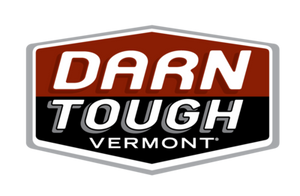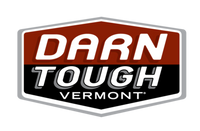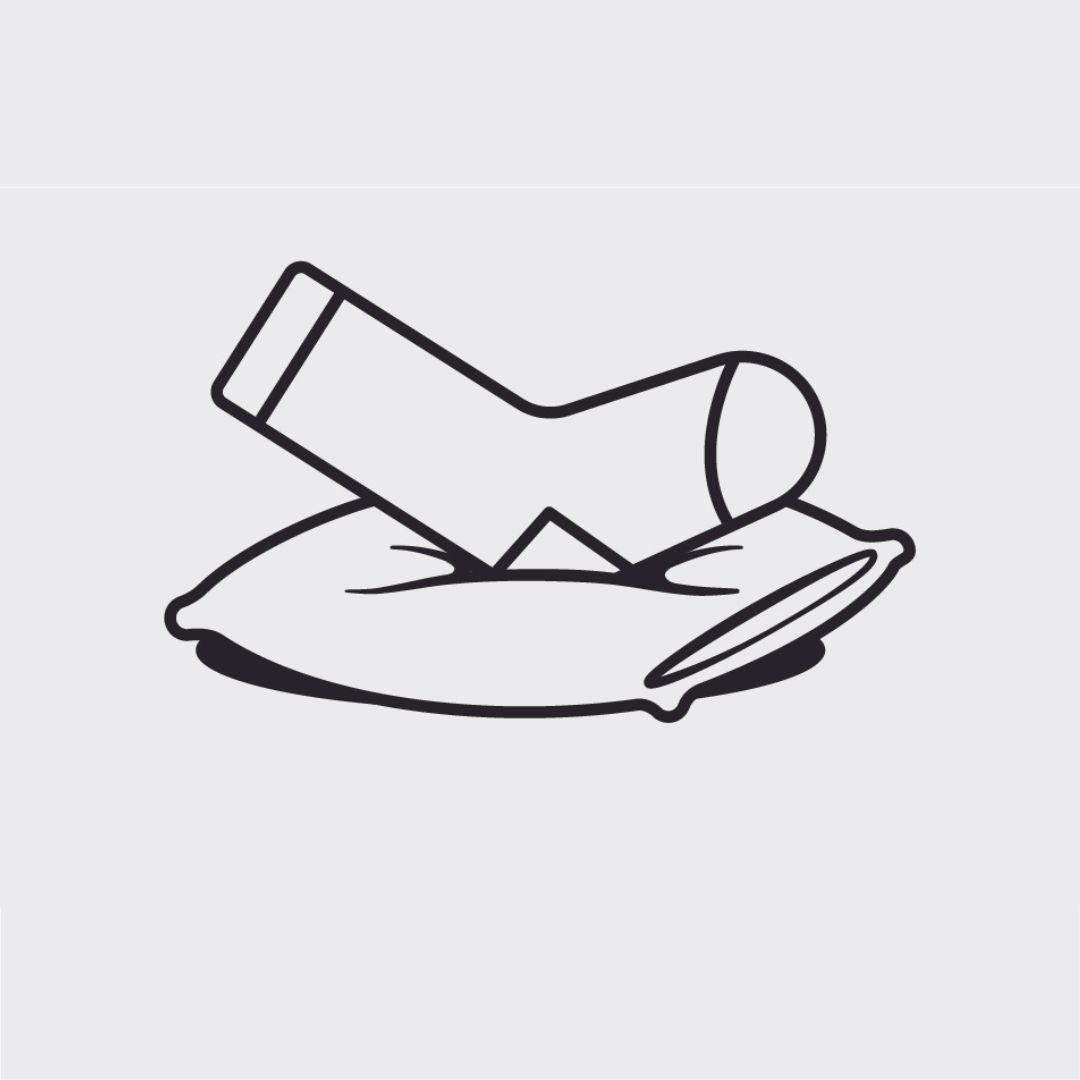Hand in Glove: A Century of Textile Manufacturing Right in Vermont
It’s early spring in Vermont, a time of year when the mountains still hold snow up high, and dirt roads are stubbornly transitioning from mud to gravel. In Randolph, the pavement is wet from an afternoon shower. GPS and smart phone are the modern ways to find the compact and unassuming industrial building at the end of Pearl Street. But once inside, it feels there might not be cell service, let alone use for an app.
A hand-made bell announces anyone who walks in the front door. In the break room, coffee mugs hang alongside bolt-cutters, shears and a wall-mounted pencil sharpener. Weathered plaster and lathe are the primary wall covering.

Sun has chased off the storm, shining through two stories of windows. Steel clutch-driven sewing tables are illuminated in the natural light, a whole row of mid-century equipment that used to run off a single steam-powered pulley system.
Employees guide pieces of cut goat leather through industrial-grade needles. Their forward and backward, folding and double-stitching dance of hand-making leather gloves rewind the clock to an era when nearly all of textile products purchased in the US were also produced in the US.
It says as much on the front of the building. “Vermont Glove Since 1920: Actually Made in Randolph, VT.”

100 Years & Counting: Making History on Pearl Street
Answering the makeshift doorbell, Vermont Glove Owner Sam Hooper kicks off a tour of the factory, fielding questions with the straight-forward ease of a 28-year old entrepreneur that’s answered countless inquiries about the leather working within. Step by step, process by process, Sam reveals the purpose for making gloves the old way, his commitment to hand-making products domestically, and the importance of creating local, skilled manufacturing jobs.

Sam bought the business in 2018 from the Haupt family, who founded and ran Green Mountain Glove since 1920. “At that time, they were only selling gloves to trade workers,” says Sam “Quality was the only thing that mattered. It wasn't about aesthetic.”
First came the name change to Vermont Glove, then the 100-year building got an update— spray foam insulation behind the ceiling boards, a biomass pellet boiler, and solar panels on the roof. Besides the new logo on the cuff, and being powered with 100% renewable energy, it’s business as usual on the factory floor.

Sam’s tour of the building follows the sound of punctuated metallic “clunks,” down a steep wooden staircase and into a walk-out basement. Windows face east toward the twin steel lines of New England Central Railroad’s train tracks.
Leather hides, ordered by different weights and thicknesses, sit ready for gauging, before being marked for quality and most efficient use. Metal dies are plunked down a tall table, the flywheel of a cast iron clicker press already thrumming away, and with a rhythmic series of “wham, wham, wham’s,” each of Vermont Glove’s unique glove patterns are cut out.

“We still use equipment in this building that was made in the 1920s, '30s,'40s, and '50s,” says Sam, recalling the moment when he stepped through the front door himself. “The one thing that was distinct when I first walked in was the immediate overwhelming smell of the leather. The aroma just filled the air, and it was clear that this was a place where something was actually being made.”
Continuing a Century of Quality
Vermont Glove carries almost no inventory, instead producing each batch of gloves to order. Whether those orders are newer styles geared toward homesteaders and even backcountry skiers and riders, or time-tested styles for the local and regional power companies that have been staple customers all along, the attention to detail is the same.
Back upstairs, a 1930’s wooden punch clock still delivers a satisfying “ding.” Cut glove pieces are arrayed on a wooden table beneath, prepared to have their grain and stretch direction re-inspected before the sewing starts.

“Our quality standard is derived from the fact that we're making gloves for electrical power line workers,” explains Sam. “And they’re relying on their gloves to protect their life. That's the reason we take the extra time to examine every piece of the leather and make sure there's no breaks in the grain.”
Alternating between explaining the steps involved, chatting with employees, and checking in on the work in progress, Sam’s movement through the factory is fluid: picking up a piece of uncut leather, then a glove in the process of being finished, then pausing to hold up the final product for a closer inspection. He’s dressed in a striped fleece button up shirt and floral patterned ballcap, but from the waist down Sam wears work pants and boots.

Balancing a customer-facing enterprise with a century-old legacy of handmade work gloves seems to be second nature, but according to Sam, it’s been a 7-day-a-week entrepreneurial rollercoaster. What keeps him committed to making gloves the way they did a century ago?
“When I first came here,” remembers Sam, “it was incredible to see a third and fourth generation of manufacturing keeping that quality program alive, even though it may not be as profitable as other channels.” Making that sort of discovery, right in Vermont, remains an inspiration. “It's pretty invigorating when you get a phone call from a lineman who retired 40 years ago, and they tell you a story about how they had a flash explosion, and that our glove saved their life.”
Learning to Make the Gloves He Couldn’t Stop Wearing
Picking up a glove in the process of being stitched closed, Sam shares that wearing the product came before wanting to be involved in the business. No stranger to working with his hands, Sam would blow through a lot of gloves on his own homestead in Brookfield, and helping out at his brother’s farm five minutes away from the factory in Randolph. “I started wearing the Green Mountain Gloves,” recalls Sam, “and I was just floored by the quality, to the point where I just didn't want to take them off.”

His enthusiasm lead to a year-long apprenticeship with the Haupts in 2016. Sam grew up in a family business, Vermont Creamery, and found similar values to the ones he’d been around his whole life. “Growing up in manufacturing, I was immediately drawn to the process, the operation, the quality assurance, the attention to detail for every little step in the process to make sure that the end product is up to snuff for the customer.”

Packaged up and waiting to be shipped out, a pair of Vermont Gloves looks as simple as a solved Rubik’s cube. That is, if you didn’t know it was a puzzle in the first place. But learning to make a glove is more like working with a dismantled puzzle, broken down into pieces. The proposition is putting it all back together, into a cube, with the colors in their places.

Sam says there was no shortage of frustration at first, while he struggled to work a material he couldn’t yet physically manipulate, or master the industrial equipment he was operating.
“I didn't have enough control over the sewing machine pedal to make sure I stayed on the leather, and didn't sew off the edge,” recalls Sam. “But Kurt Haupt was determined to make sure I sat there and kept doing the same process over and over again until I got it down, then I would graduate to the next step.”

The reward of finally being able to make the gloves stuck with Sam, and he says that the experience is repeated with every person that they’ve hired. In many ways, Sam was the test case for what he knew would have to happen for the business to continue.
“I knew if I couldn’t learn how to do this,” says Sam, “then we're going to have a really hard time teaching other people how to do it. There's just not that many industrial gloves sewers left in the world. Our job is to create them. That diligence standard, that training process is core to our company.”
Human Resources at Its Finest
The tour continues through the main floor, where a staccato of sewing sounds pepper the air. Foot pedals are feathered with skilled expertise, air pistons release, backtacks, welts and closing stitches are executed. Elastic, cuffs and buckles are sewn on.
Each of the 40-plus styles of glove takes eight to twelve pieces and twelve manufacturing steps, and this is where the laid-out pieces from the inspection table are meticulously assembled. Sam points out what seems like an oddity— having seams on the outside of the glove.

“After use,” says Sam, “the seams roll back, and they're positioned. They're engineered and designed to position in places where they're not going to be a burden to your dexterity or the use performance of the glove.”

It’s a design choice that allows for using a heavier gauge thread and needle, and double stitching seams for durability. The finish doesn’t end there. Working from a stack of just-stitched gloves, shears are used to trim off excess leather around all the seams. Next, the gloves are pulled onto a hand-shaped metal form, another product leftover from the steam era and now electrically heated, to be softened, and all the spaces between the digits smoothed with a metal paddle.

An afternoon visit might leave most folks equal parts mesmerized by the history of the Vermont Glove factory, and confounded by multi-faceted, demanding, unintuitive production steps put into place decades ago. Start-to-finish, it’s straight-up labor-intensive, expensive, and time-consuming.
“Folks who wear our gloves are the people getting their hands dirty,” says Sam, “and that's a reflection of what we do here as a company. We are making the hardest product in the cut and sew textile leatherwork industry possible.”

Vermont Glove makes their gloves this way not just because that’s how they’ve always made gloves, but because given the goat leather they work with, and the comfort and quality the company has stood for, it’s really the only way.
“Every cut piece of leather is different,” says Sam, “from stretch direction, to thickness. You have to figure out how to nest a hide and lay it out, how to maximize the use of it. Ultimately, you're trying to create a three-dimensional product out of flat pieces of a material that’s different from hide to hide. There's no way to automate that. There's certainly a craft. I would go as far as to say that there is an art.”
It Takes a Wearer to Bring It to Life
The Rubik’s cube analogy may play for the complexity hiding beneath the simple, utilitarian appearance of Vermont Glove’s product. But it doesn’t speak to the life they take on after leaving the factory.
In the wood paneled alcove that he uses as an office, Sam’s own heavily-used, browned pair sit on a table next to a crescent wrench. The gloves are a tactile wonder, the broken-in leather unlocking the difference between a brand-new pair that Vermont Glove produces every day, and a pair that’s been broken in by hours of wear. There’s a vitality to them. You can sense the shape of the hands that wear them.

“The real accomplishment is when we see that well-worn pair of gloves that's been through hell and back working on the job,” says Sam. “The glove reflects every contour of your hand. It might be covered with hydraulic fluid or have a bloodstain on it, or whatever it may be. That relationship that you develop using your hands on the job, you start to create memories and experiences with those gloves.”
For Heidi Haupt, Vermont Glove Operations Manager, that weathered and time-worn look is a mark of longevity and legacy. “Being fourth generation, there’s a sense of pride with continuing with the quality, and knowing that that has always been a part of it,” says Heidi. “We’re still making a pair of gloves that are going to last someone, that they are going to want to put on to wear, and to be their choice.”
Investing in Jobs, Investing in Community
Leather hide to clicker press to sewing machines and finishing, Sam’s tour of the factory and the process of glove making is mostly wrapped up. Taking a pause, he lets the crew know he’ll be stepping out for a moment to deliver the mail and go to the bank. It’s an easy moment of communication, like the one later on, when Sam is back at his desk, and employees start to leave for the day. Goodbyes, or ‘buenas noches,’ are offered with casual, friendly familiarity.

“Our team is like a big family,” says Sam. “You can see that in all of our interactions. We have people from all walks of life who are welcome here. This facility is a safe haven for that and for us to express our values as a company. We understand right from wrong and we speak up about it on policy issues, on climate issues, you name it. This is our home.”
Vermont Glove earned its reputation on protecting the lives and livelihoods of trade-workers. That’s not something Sam plans on letting go. Yet, looking around the factory floor, and catching the atmosphere, it’s clear that Vermont Glove doesn’t stand for quality for the glove wearers alone. They’re building jobs in a labor market where quality employment isn’t a given, especially when it comes to training and retaining skilled workers.

On the horizon is an group effort that Sam started to bringing textile manufacturing back to career curriculums at vocational centers. But his latest project is already putting roofs over heads: converting a shuttered residential care facility in Randolph into a net-zero building for staff housing.
“Investing in meaningful jobs and a company culture that people want to be a part of, allowing people to stay here in the community that they grew up in, or come to this community and create a better life for themselves— that's the business that we're in,” says Sam. “That's one of the reasons we get out of bed in the morning.”
If These Machines Could Speak
After the factory floor has emptied, Sam takes a seat between the two rows of sewing machines. There’s an openness to the space, a reverent hush around the machines that buzzed and clanged with noise and the studied concentration of the employees operating them just minutes before. Sam cracks a beer to end the day, and wrap up the conversation. It seems like good timing to ask a more philosophical “what if” question. He’s game.

“What if these machines could speak? They’d tell a story about workmanship,” says Sam. “They'd tell a story about how things are made. They would tell a story about generations of workers putting in long hours in front of them, and they'd tell a story about how to take care of what takes care of you.”
About the Author
Jesse Huffman is a writer, video director, and appreciator of hand-crafted goods. A Vermont-based outdoors lover, he’s keen on gravel, snow, and all the elements in between. Find out more at jessehuffman.com.







